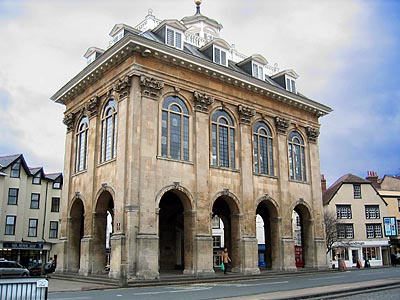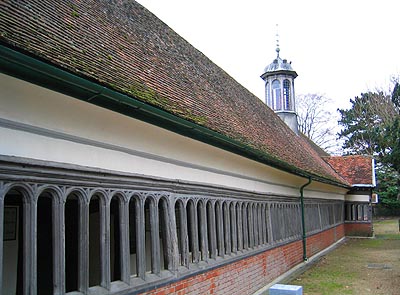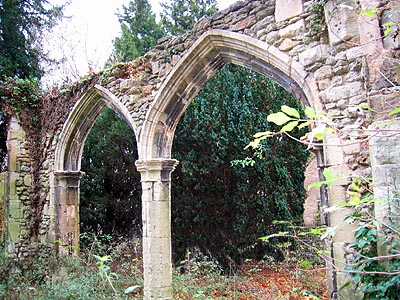 |
 |
|||
|
|
Abingdon holds claim to the title of Britain's oldest town. As an organised unit, it was first established in the late Iron Age as an 'enclosed oppidum' or valley-fort (the opposite of a hillfort). Double ten-metre-wide ditches ringed the area of the present town in a semi-circle between the Ock and the Thames. Unlike similar ditches around contemporary hillforts, these were filled with water, fed by the River Stert. Over fifteen hectares of the interior is thought to have been densely occupied by round houses, post-built structures and storage pits. Land of about equal area was probably used as pasture for livestock. Finds include Celtic coins and imported pottery, indicating that - probably due to its position on the borders of three tribes - Abingdon was quite a market centre even at its birth. During the Roman period, Abingdon developed into a small Roman town. A number of buildings have been identified by excavations, with stone walls from the 2nd century onward. Pottery scatters indicate some sort of shift in focus in the 4th century. Communication by river must have always been important to the town, for there was no major Roman through-road here, only a road across to the religious settlement at Frilford, to the west. Rural settlements were also important on the outskirts of the later Abingdon parishes. The Roman villa excavated at Barton Court, though relatively modest in appearance and decor, has revealed much about the everyday workings of farms of this period. The town's history is closely intertwined with that of its Abbey. Abingdon Abbey claimed to be the first monastery to be set up in Britain. A title strongly contested by Glastonbury, which was said to have been founded by St. Joseph of Arimathea in AD 63. A discredited legend says Abingdon's origins lie with the evangelists, SS. Medwy & Elfan, who Pope Eleutherius sent over to the Roman client-King, Lucius of the Catuvellauni, in AD 166. Another tradition says that St. Helen herself later founded a church on the site of the present one dedicated to her memory. Her son, the Roman Emperor Constantine, gave her foundation one of the nails from the Holy Cross of the Crucifixion, which his mother had found in Jerusalem. St. Birinus later restored this Roman church, and it became a Saxon Minster, standing within a Royal estate. The Witan (Saxon parliament) is known to have met there in AD 989. St. Helen's is said to be the second widest church in the country, having a nave and four huge 15th century aisles. The church's finest treasure is the beautiful painted ceiling of the Lady Chapel. Dated about 1391, its fifty-two panels feature Christ's ancestors (a Jesse Tree). The church contains the Mayor's seat, complete with sword-rest, and was home to the Fraternity of the Holy Cross. This was a kind of guild set up by King Henry VI in the early 1440s, and dedicated to the Holy Cross for obvious reasons. Behind St. Helen's stands the delightful Christ's Hospital (or Long Alley Almshouses) founded by the brotherhood a few years later. A charming wooden cloister walk was added in the 17th century. There are three further sets of almshouses nearby.
Abingdon has an impressive Anglo-Saxon heritage. Some of the earliest Germanic settlers in Britain have been identified in an Abingdon cemetery. One group of male burials there seem to have been deliberately set apart for at least two generations and, from their Frankish swords, it would appear that they were a warrior class. During King Alfred the Great's reign, the Abbey was burnt to the ground by the Danes from Reading, and there was a small skirmish outside the town. A superb Saxon sword from this period was found in the Thames at Abingdon. It has a silver covered pommel decorated with foliage and leopard heads. Below, among fine interlace work are a man, an eagle, a lion and a cow: the symbols of Matthew, Mark, Luke and John. King Edgar the Peacemaker was educated at Abingdon Abbey by St. Aethelwold, the Abbot. The monastery was then in a very ruinous state and he promised that if he became King he would strive to restore all neglected churches. Shortly after his coronation, he held good to his word, for Abingdon was the first of several Abbeys to be rebuilt. St. Aelfstan was a monk at Abingdon under Aethelwold before becoming Bishop of Ramsbury & Sonning. While inspecting his new church buildings one day, Aethelwold came across Aelfstan, in the kitchen, preparing dinner for the workmen. Struck by a sudden impulse to test Aelflstan's obedience, the Abbot ordered him to thrust his hand into a boiling cauldron to retrieve a dumpling from the bottom. Aelfstan did so, and miraculously pulled both dumpling and his unscathed hand from the pot! St. Aelfstan died in AD 971 and, though he was buried at Abingdon, the monks seem to have made little of his saintly remains. Pilgrims flocked to Abingdon Abbey during the Middle Ages for it held the great Nail of the Holy Cross, inherited from St. Helen's. The Abbey also held the relics of St. Vincent. During King Canute's reign, the monks had stolen them from their brethren of Glastonbury whilst they were staying at the Abbey. The King approved and gave them a fine silver & gold shrine in which to house the bones. It was inscribed with the names of the King, his wife & Abbot Aethelwin. Aethelwin gave another shrine for relics he had collected & a splendid silver cross. Abingdon also acquired relics of St. Edward the Martyr during Canute's reign. The young saint had visited the shrine of Our Lady of Abingdon (said to be the oldest in England and housing a Roman sculpture of the Virgin) during his short time as king. Later, his own shrine at Shaftesbury Abbey was sending out parts of his body to Glastonbury, Salisbury, Leominster & Durham. On travelling through Berkshire, the relic bearers were miraculously halted at Abingdon. As the saint evidently wanted to stay in the town, they decided to leave many of his bones in the Abbey Church. Abingdon venerated the relics of many other saints too. The following are buried at Abingdon Abbey:
One wonders if any of the fabulous memorials, that must have existed within the Abbey Church, were made by Alexander of Abingdon. Also known as Alexander the Imager, this local man was among the greatest of medieval English sculptors. Unfortunately, only three pieces of work, definitely known to be his, still exist: the statues of Queen Eleanor of Castile from the Eleanor Cross at Waltham in Hertfordshire, for which he was paid 5 marks each (£3 6s 8d). These can be seen in the Victoria and Albert Museum (those on the cross are now copies). The Eleanor Crosses were put up by Edward I to show where his beloved wife's body had rested on its journey from Lincolnshire to Westminster Abbey in the Winter of 1290. Alexander also worked on the great Charing Cross and Queen Eleanor's monuments in Lincoln Cathedral and the Blackfriars' (London). Such Royal commissions clearly show his pre-eminence in the medieval Art World. He is thought to have been the principal sculptor of the Westminster or Court School of Art. Other monuments attributed to him are those to:
Alexander may have made his way to London through his association with the King's painter, Walter of Durham. Walter is known to have undertaken work at Abingdon Abbey and Alexander probably learnt his craft from Abbey masons there. They appear to have been quite a centre for sculptural inspiration, for there were other Abingdon sculptors abroad, like John of Abingdon who worked on Merton College Chapel (Oxford).
There isn't much left of Abingdon Abbey today. It lies buried beneath the Abbey Gardens. Don't be fooled by the sham ruin there. It's only a folly put up in the 1920s. Some of the stones do come from the old buildings though. The Abbey gateway is the most obvious of the Abbey's remains. This beautiful 15th century building adjoins the Norman Church of St. Nicholas, also built by the monks on the edge of their enclave. St. Edmund of Abingdon's mother was buried here (before being removed to a nearby cemetery chapel), as recorded by a small plaque. St. Edmund was the eldest son of an Abingdon merchant who was so wealthy he could afford to send his offspring to University in Oxford (where St. Edmund's Hall is named after him). Edmund became Treasurer of Salisbury and eventually rose to be Archbishop of Canterbury. In 1240, he died on his way to see the Pope in Rome. He was buried in Pontigny Abbey where his shrine became an important pilgrimage centre. The people of Abingdon built a small chapel dedicated to him on the site of his birthplace in St. Edmund's Lane. On the opposite side of the Abbey Gate is the old guesthouse or hospitium of St. John. (There are obvious parallels with Reading Abbey.) The building became the town's council chambers and was drastically altered in 1731. An unexpected delight from the Abbey's past is the 13th century Exchequer Building with the finest medieval chimney in the country. Adjoining is a superb timber framed long gallery of about 1500. One of the Abbey's institutions which seems to have survived the Dissolution was its educational facility, which is today known as Abingdon School. Its earliest history is difficult to trace. It was certainly in existence in 1372, but a certain Richard the Pedagogue is claimed to have been the first recorded headmaster in 1100. Its origins probably lie in St. Aethelwold's instruction of King Edgar and other noble children in the AD 950s, making it one of the top twelve oldest schools in the country! With the departure of the monks, Christ's Hospital (the successor to the Fraternity of the Holy Cross) kept the school going until it was refounded in 1563 by John Roysse, an Abingdonian who had made his fortune as a merchant in London. He desired to create some new heirs for himself after disinheriting his son for he "hath married against my will another man's wife, as doth appear in the spiritual court of record here in London; and further, for that he hath been associated and accompanied with thieves and pirates." The school has had many famous masters and pupils, including: Sir John Mason, Sir Thomas Smith, Degorie Wheare, Dr. Thomas Godwin, Sir Edward Turnour, Sir John Holt, Clement Saxton, Sir Thomas Head, Richard Graves, Archbishop William Newcome, Charles Abbot (Lord Colchester) and Dr. John Lempriere. Rebellion always remained popular in Medieval Abingdon and, in 1381, it was the only town in Berkshire to which officials were sent to arrest supporters of the Peasants' Revolt. Fifty years later, Abingdon was the centre of Jack Sharpe's Rising. It was a rebellion ostensibly against the protectorship of the Duke of Gloucester, although the local popularity of its Abingdon ringleader seems to have stemmed from continued jealousy of the powers of the Abbey. The Duke himself squashed the rebels and Jack Sharpe's head was sent to London on a pole. Seven years later, the Fraternity of the Holy Cross set up the town's once famous market cross in front of the Abbey Gates. It was a monument to the town and probably went some way to reasserting Civic pride after recent demoralizing events. One of the most fabulous stone crosses in the country, it stood some 57ft high and consisted of four, mostly hexagonal, tiers with niches and finely carved statues. There were six each of kings, virgins & prelates and prophets. These included King David and the Virgin Mary, and probably local patrons, such as:
The main structure of the cross was almost entirely rebuilt, in 1605, by Christ's Hospital. At this time, it became covered with the arms of the hospital's members, most of the local Landed Gentry. Those of John Golafre of Fyfield Manor and Hugh Unton of Faringdon remained from the original cross, but amongst the new arms were those of:
Abingdon has the grandest town hall in England. A fine classical building built in 1678/82 by Wren's mason who created the Dome of St. Paul's. It is of the open-ground-floor type usually associated with small market towns. Its size, however, is hugely out of proportion to the size of the community. The building became the county hall when Abingdon was made Berkshire's county town. It remained so until 1867, when Reading took over. Masked men of the road, on the whole, preferred the rich pickings of the Bath Road to North Berkshire, but the area was not totally devoid of their exploits. One highwayman bit off more than he could chew when he held up a post-chaise just outside Abingdon in 1773. He took a watch from one traveller and money from another, but the third told him he'd have to shoot him if he wanted his valuables. The confused gentleman of the road hesitated, then turned and galloped away. The triumphant passengers unhooked their horses and gave chase. They soon caught him up and sent him off to the magistrate and Reading Gaol. For Shippon, Wildmoor, Northcourt, FitzHarris and Barton see Abingdon St. Helen's Without Click for the
Abingdon
Stop on the Berkshire Towns
Tour |
|||
| © Nash Ford Publishing 2004. All Rights Reserved. This location is now administered by Oxfordshire County Council. | ||||



 Abingdon
Abingdon In
the fifth century, the legendary
In
the fifth century, the legendary  While
the Abbey provided employment in the town and set men like Alexander
onto a lucrative career, it was not a universally popular institution.
In fact, quite the opposite was true. The townsfolk were jealous of the
Abbot's hold over Abingdon and particularly his control of the market.
Things came to a head in 1327. An angry group of men tried to burn down
the Abbey gate but the monks defended themselves and killed two of their
attackers, while capturing several others. These were later released but
the townsfolk were furious and sent to Oxford for reinforcements. A few
days later, a huge crowd of Oxfordians arrived in the middle of the
night and
While
the Abbey provided employment in the town and set men like Alexander
onto a lucrative career, it was not a universally popular institution.
In fact, quite the opposite was true. The townsfolk were jealous of the
Abbot's hold over Abingdon and particularly his control of the market.
Things came to a head in 1327. An angry group of men tried to burn down
the Abbey gate but the monks defended themselves and killed two of their
attackers, while capturing several others. These were later released but
the townsfolk were furious and sent to Oxford for reinforcements. A few
days later, a huge crowd of Oxfordians arrived in the middle of the
night and  In
May 1644, the magnificent cross was totally destroyed by the Puritanical
Roundhead troops stationed in the town. They had just returned from an
unsuccessful attempt to cross the Thames at Newbridge and attack Oxford.
Thus thwarted, they took their anger out on the town's great monument.
Abingdon had not long been under Parliament's control. Being so near to
Oxford, it was originally a Royalist town, but was taken by Essex and
Waller more through luck than judgement. The Royalists had retreated and
found, too late, that the King wished them to hold the town with
reinforcements from
In
May 1644, the magnificent cross was totally destroyed by the Puritanical
Roundhead troops stationed in the town. They had just returned from an
unsuccessful attempt to cross the Thames at Newbridge and attack Oxford.
Thus thwarted, they took their anger out on the town's great monument.
Abingdon had not long been under Parliament's control. Being so near to
Oxford, it was originally a Royalist town, but was taken by Essex and
Waller more through luck than judgement. The Royalists had retreated and
found, too late, that the King wished them to hold the town with
reinforcements from